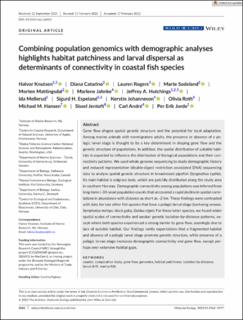| dc.contributor.author | Knutsen, Halvor | |
| dc.contributor.author | de Oliveira Catarino, Diana Sofia | |
| dc.contributor.author | Rogers, Lauren | |
| dc.contributor.author | Sodeland, Marte | |
| dc.contributor.author | Mattingsdal, Morten | |
| dc.contributor.author | jahnke, marlene | |
| dc.contributor.author | Hutchings, Jeffrey | |
| dc.contributor.author | Mellerud, Ida Kristin | |
| dc.contributor.author | Espeland, Sigurd Heiberg | |
| dc.contributor.author | Johanneson, Kerstin | |
| dc.contributor.author | Roth, Olivia | |
| dc.contributor.author | Hansen, Michael Møller | |
| dc.contributor.author | Jentoft, Sissel | |
| dc.contributor.author | Andre, Carl | |
| dc.contributor.author | Jorde, Per Erik | |
| dc.date.accessioned | 2022-06-30T10:09:02Z | |
| dc.date.available | 2022-06-30T10:09:02Z | |
| dc.date.created | 2022-05-18T13:10:58Z | |
| dc.date.issued | 2022 | |
| dc.identifier.citation | Molecular Ecology. 2022, 31 (9), 2562-2577. | |
| dc.identifier.issn | 0962-1083 | |
| dc.identifier.uri | https://hdl.handle.net/11250/3001741 | |
| dc.description.abstract | Gene flow shapes spatial genetic structure and the potential for local adaptation. Among marine animals with nonmigratory adults, the presence or absence of a pelagic larval stage is thought to be a key determinant in shaping gene flow and the genetic structure of populations. In addition, the spatial distribution of suitable habitats is expected to influence the distribution of biological populations and their connectivity patterns. We used whole genome sequencing to study demographic history and reduced representation (double-digest restriction associated DNA) sequencing data to analyse spatial genetic structure in broadnosed pipefish (Syngnathus typhle). Its main habitat is eelgrass beds, which are patchily distributed along the study area in southern Norway. Demographic connectivity among populations was inferred from long-term (~30-year) population counts that uncovered a rapid decline in spatial correlations in abundance with distance as short as ~2 km. These findings were contrasted with data for two other fish species that have a pelagic larval stage (corkwing wrasse, Symphodus melops; black goby, Gobius niger). For these latter species, we found wider spatial scales of connectivity and weaker genetic isolation-by-distance patterns, except where both species experienced a strong barrier to gene flow, seemingly due to lack of suitable habitat. Our findings verify expectations that a fragmented habitat and absence of a pelagic larval stage promote genetic structure, while presence of a pelagic larvae stage increases demographic connectivity and gene flow, except perhaps over extensive habitat gaps. | |
| dc.language.iso | eng | |
| dc.title | Combining population genomics with demographic analyses highlights habitat patchiness and larval dispersal as determinants of connectivity in coastal fish species | |
| dc.title.alternative | Combining population genomics with demographic analyses highlights habitat patchiness and larval dispersal as determinants of connectivity in coastal fish species | |
| dc.type | Peer reviewed | |
| dc.type | Journal article | |
| dc.description.version | publishedVersion | |
| dc.source.pagenumber | 2562-2577 | |
| dc.source.volume | 31 | |
| dc.source.journal | Molecular Ecology | |
| dc.source.issue | 9 | |
| dc.identifier.doi | 10.1111/mec.16415 | |
| dc.identifier.cristin | 2025215 | |
| cristin.ispublished | true | |
| cristin.fulltext | original | |
| cristin.qualitycode | 2 | |
